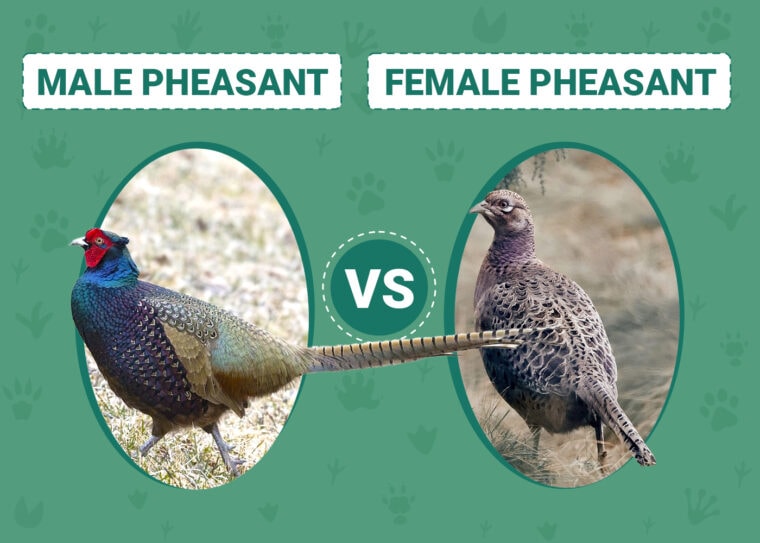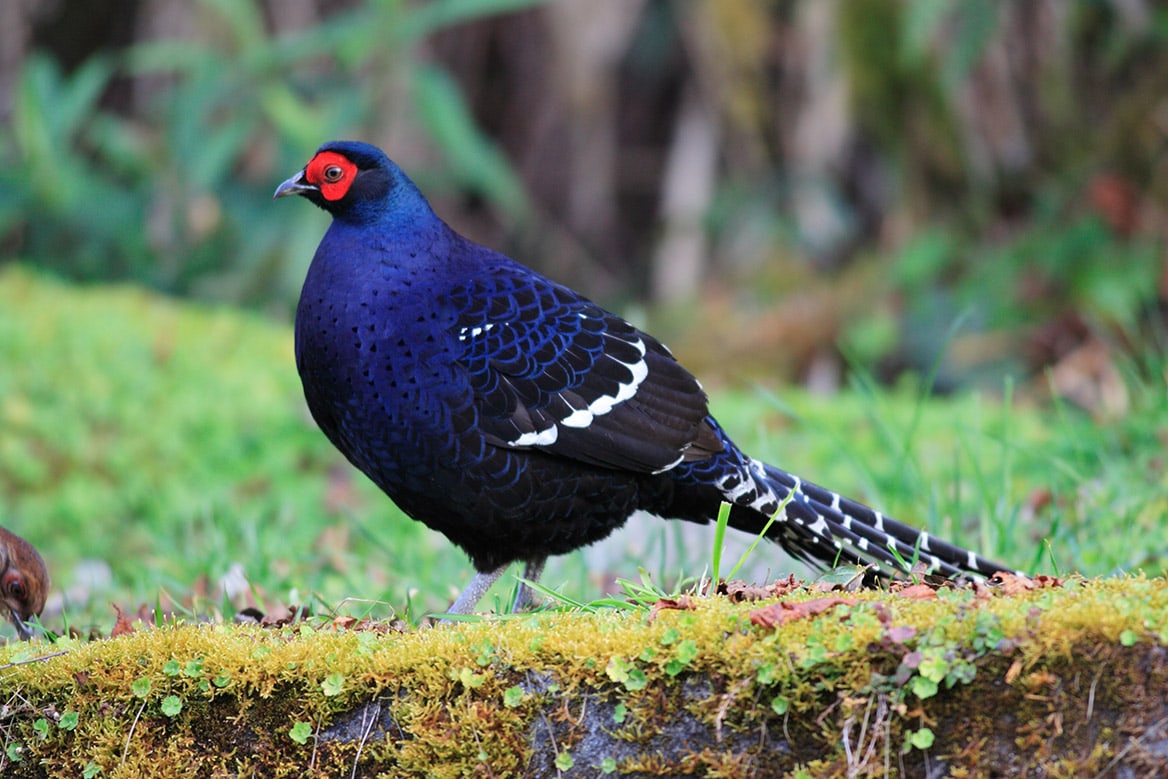
Click to Skip Ahead
While it can be difficult to distinguish between many kinds of male and female animals, pheasants are a different story. Male and female pheasants have stark differences in appearances and can also vary in size, and this is true of all pheasant breeds. Owners can also find different uses for males and females.
Here’s a breakdown of the similarities and differences between male and female pheasants.
Visual Differences

At a Glance
Male Pheasant Overview

Characteristics & Appearance
Male pheasants have more elaborate and vibrant feathers than females. They can display a wide range of colors, including bright green, blue, velvet, and red. Males need to impress female pheasants to increase their chances of success during breeding seasons, and their vibrant plumage can be used to attract females.
Males also tend to be larger than females. So, the combination of size and vibrant colors can make them more appealing. They also perform an elaborate courtship dance that usually involves displaying their feathers and puffing themselves up to appear bigger.
Males also become particularly territorial during mating season. They will start to crow to attract female pheasants within their territory. Because they can become aggressive and competitive, you can only have a few males within a flock of pheasants.
Uses
Aside from mating, males are often harvested for their meat or released for game hunting. Male pheasants are ideal targets for hunting because of their bright colors. Since they aren’t as camouflaged as their female counterparts, they’re easy game and a favorite amongst beginner hunters.
Although male and female pheasants differ in size, they don’t have any differences in taste. As long as they’re fed the same diet, both males and females will taste the same. Their meat tastes similar to chickens but tends to be a bit gamier and have a more nuanced flavor profile.
Female Pheasant Overview

Characteristics & Appearance
While male pheasants have extravagant and vibrant plumes, the female pheasant has duller feathers that are usually earth-toned. While their appearance may not look impressive at first glance, it’s necessary for survival in the wild. As female pheasants have to protect their young, it’s essential that they can camouflage well and stay hidden from their natural predators.
Female pheasants typically aren’t as aggressive or territorial as male pheasants. In fact, larger numbers of female pheasants can live together. However, they can start to pick on each other if they live in tight quarters and don’t have enough space to forage and roam. So, it’s important to provide ample space for these birds. In extreme cases of overcrowding, they can become severely competitive and even turn cannibalistic.
Uses
Like male pheasants, female pheasants are primarily raised for their meat. They can also be used as game, and they’re more challenging to hunt since they camouflage much more effectively than males.
Growers can also raise female pheasants for eggs. However, they don’t lay eggs as frequently or efficiently as chickens do. Female pheasants only lay eggs during their breeding season and can lay 50 to 60 eggs at most.
Pheasant eggs are smaller than chicken eggs. They taste pretty similar, but some people note that pheasant eggs have a slightly richer taste and texture. These eggs can be cooked and served like chicken eggs, so it’s common to see them hard boiled or scrambled. They also make delicious omelets and quiches.
What Are the Differences Between Male and Female Pheasants?
While male and female pheasants have stark appearances when they’re mature, it can be difficult differentiating between the two when their young hatchlings. All young pheasants look like young females. One of the reasons why male hatchlings don’t have vibrant feathers from birth is because they’re more vulnerable and benefit from camouflaging.

Spot the Wattle
A trained eye can find the subtle differences between young male and female pheasants. One of the main ways to determine if a pheasant is a male is to look for a more pronounced wattle. Female pheasants won’t show a prominent wattle.
The Importance of Sexing
It’s important to properly sex young pheasants to avoid facing issues further down the road. If a female pheasant gets mixed in a pen with male pheasants, the males will become more aggressive towards each other when they reach sexual maturity. They will feel the drive to compete over mating because of the scarcity of female pheasants.
Different Purposes
Along with appearances, male and female pheasants have different purposes for growers. Male pheasants are mainly grown for mating purposes and for meat. Along with meat, farmers and growers can collect the eggs that female pheasants lay.
Which Pheasant Gender Is Right For You?
For the most part, male and female pheasants serve similar uses, and they’re mostly harvested for their meat and used as game birds. However, males are favored as game birds because of their flight and vibrant feathers. Females are more favorable if you’re trying to raise a flock because they tend to be less territorial, and you can also harvest quite a few eggs from them.
So, if you’re strictly looking for game birds, a male pheasant is more suitable for you. If you’d like to raise many birds and also harvest eggs, a female pheasant is the better choice.
See Also:
- Mikado Pheasant: Pictures, Facts, Uses, Origins & Characteristics
- Do Pheasants Mate for Life? What You Need To Know!
Featured Image Credit: (L) Martine Liu 58, Shutterstock | (R) JamesHou, Shutterstock









